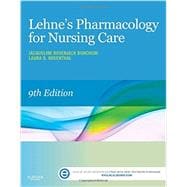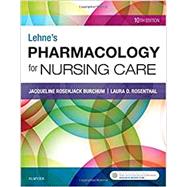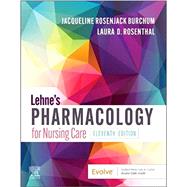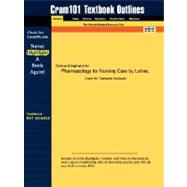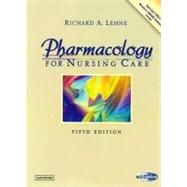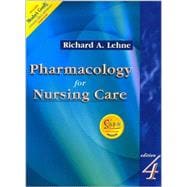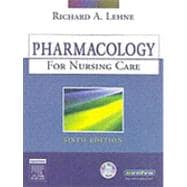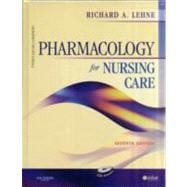Pharmacology for Nursing Care
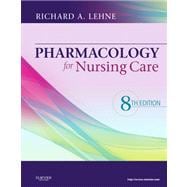
Pharmacology for Nursing Care
- ISBN 13:
9781437735826
- ISBN 10:
1437735827
- Edition: 8th
- Format: Hardcover
- Copyright: 04/24/2012
- Publisher: W B Saunders Co
- Newer Edition
Rent
Sorry, this item is currently unavailable.
Note: Supplemental materials are not guaranteed with Rental or Used book purchases.
Extend or Purchase Your Rental at Any Time
Need to keep your rental past your due date? At any time before your due date you can extend or purchase your rental through your account.
Summary
A favorite among nursing students, Pharmacology for Nursing Care, 8th Edition, features a uniquely engaging writing style, clear explanations, and unmatched clinical precision and currency to help you gain a solid understanding of key drugs and their implications - as opposed to just memorization of certain facts. Compelling features such as a drug prototype approach, use of large and small print to distinguish need-to-know versus nice-to-know content, and a focus on major nursing implications save you study time by directing your attention on the most important, need-to-know information. The new edition also features an abundance of content updates to keep you ahead of the curve in school and in professional practice. UNIQUE! Engaging writing style with clear explanations makes content easy to grasp and even enjoyable to learn. A drug prototype approach uses one drug within each drug family to characterize all members of its group to help you learn about related drugs currently on the market and drugs that will be released once you begin practice. UNIQUE! Special Interest Topic boxes address timely issues in pharmacology and connect pharmacology content with current trends. Large print/small print design distinguishes essential "need-to-know" information from "nice-to-know" information. Limited discussion of adverse effects and drug interactions keeps your limited study time focused on only the most clinically important information. Reliance on up-to-date evidence-based clinical guidelines ensures that therapeutic uses are clinically relevant. Integrated and summarized nursing content demonstrates the vital interplay between drug therapy and nursing care. Coverage of dietary supplements and herbal interactions equips you to alert patients and caregivers to the potential dangers of certain dietary supplements, including interactions with prescribed and over-the-counter drugs and herbal therapies. Additional learning features provide a touchstone for study and review as you complete reading assignments and build a foundation of pharmacologic knowledge. Updated drug content and related nursing content reflect the very latest FDA drug approvals, withdrawals, and evidence-based therapeutic uses. Expanded and updated content on medication safety prepares you to pass the NCLEX Examination and practice safe medication administration in the clinical setting. Expanded coverage of pharmacogenomics introduces you to the many different genetic factors that influence drug therapy. New information on electronic prescribing primes you for nursing practice in the 21st century, as electronic prescribing systems become more common in the clinical setting. Updated coverage of evidence-based clinical treatment guidelines, particularly those for cholesterol and diabetes management, promotes evidence-based practice in nursing pharmacology. New chapter (Chapter 39) on nicotine and tobacco abuse highlights our growing understanding of the unique addictive properties of nicotine and the nursing considerations for helping patients improve their health through smoking cessation. Canadian drug names are now included and highlighted with a maple leaf icon to familiarize U.S readers with other trade names they may see and to make the book more useful for Canadian students. I. INTRODUCTION 1. Orientation to Pharmacology 2. Application of Pharmacology in Nursing Practice 3. Drug Regulation, Development, Names, and Information II. BASIC PRINCIPLES OF PHARMACOLOGY 4. Pharmacokinetics 5. Pharmacodynamics 6. Drug Interactions 7. Adverse Drug Reactions and Medication Errors 8. Individual Variation in Drug Responses III. DRUG THERAPY ACROSS THE LIFESPAN 9. Drug Therapy During Pregnancy and Breast-Feeding 10. Drug Therapy in Pediatric Patients 11. Drug Therapy in Geriatric Patients IV. PERIPHERAL NERVOUS SYSTEM DRUGS 12. Basic Principles of Neuropharmacology 13. Physiology of the Peripheral Nervous System 14. Muscarinic Agonists and Antagonists 15. Cholinesterase Inhibitors and Their Use in Myasthenia Gravis 16. Drugs That Block Nicotinic Cholinergic Transmission: Neuromuscular Blocking Agents and Ganglionic Blocking Agents 17. Adrenergic Agonists 18. Adrenergic Antagonists 19. Indirect-Acting Antiadrenergic Agents V. CENTRAL NERVOUS SYSTEM DRUGS 20. Introduction to Central Nervous System Pharmacology 21. Drugs for ParkinsonÕs Disease 22. AlzheimerÕs Disease 23. Drugs for Multiple Sclerosis 24. Drugs for Epilepsy 25. Drugs for Muscle Spasm and Spasticity 26. Local Anesthetics 27. General Anesthetics 28. Opioid (Narcotic) Analgesics, Opioid Antagonists, and Nonopioid Centrally Acting Analgesics 29. Pain Management in Patients with Cancer 30. Drugs for Headache 31. Antipsychotic Agents and Their Use in Schizophrenia 32. Antidepressants 33. Drugs for Bipolar Disorder 34. Sedative-Hypnotic Drugs 35. Management of Anxiety Disorders 36. Central Nervous System Stimulants and Attention-Deficit/Hyperactivity Disorder 37. Drug Abuse I: Basic Considerations 38. Drug Abuse II: Alcohol 39. Drug Abuse III: Nicotine and Smoking NEW! 40. Drug Abuse IV: Major Drugs of Abuse Other Than Alcohol and Nicotine VI: DRUGS THAT AFFECT FLUID AND ELECTROLYTE BALANCE 41. Diuretics 42. Agents Affecting the Volume and Ion Content of Body Fluids VII: DRUGS THAT AFFECT THE HEART, BLOOD VESSELS, AND BLOOD 43. Review of Hemodynamics 44. Drugs Acting on the Renin-Angiotensin-Aldosterone System 45. Calcium Channel Blockers 46. Vasodilators 47. Drugs for Hypertension 48. Drugs for Heart Failure 49. Antidysrhythmic Drugs 50. Prophylaxis of Coronary Heart Disease: Drugs That Help Normalize Cholesterol and Triglyceride Levels 51. Drugs for Angina Pectoris 52. Anticoagulant, Antiplatelet, and Thrombolytic Drugs 53. Management of ST-Elevation Myocardial Infarction 54. Drugs for Hemophilia 55. Drugs for Deficiency Anemias 56. Hematopoietic Agents VIII. DRUGS FOR ENDOCRINE DISORDERS 57. Drugs for Diabetes Mellitus 58. Drugs for Thyroid Disorders 59. Drugs Related to Hypothalamic and Pituitary Function 60. Drugs for Disorders of the Adrenal Cortex IX. WOMEN''S HEALTH 61. Estrogens and Progestins: Basic Pharmacology and Noncontraceptive Applications 62. Birth Control 63. Drug Therapy of Infertility 64. Drugs That Affect Uterine Function X. MEN''S HEALTH 65. Androgens 66. Drugs for Erectile Dysfunction and Benign Prostatic Hyperplasia XI. ANTI-INFLAMMATORY, ANTIALLERGIC, AND IMMUNOLOGIC DRUGS 67. Review of the Immune System 68. Childhood Immunization 69. Immunosuppressants 70. Antihistamines 71. Cyclooxygenase Inhibitors: Nonsteroidal Anti-inflammatory Drugs and Acetaminophen 72. Glucocorticoids in Nonendocrine Diseases XII. DRUGS FOR BONE AND JOINT DISORDERS 73. Drug Therapy of Rheumatoid Arthritis 74. Drug Therapy of Gout 75. Drugs Affecting Calcium Levels and Bone Mineralization XIII. RESPIRATORY TRACT DRUGS 76. Drugs for Asthma 77. Drugs for Allergic Rhinitis, Cough, and Colds XIV. GASTROINTESTINAL DRUGS 78. Drugs for Peptic Ulcer Disease<




